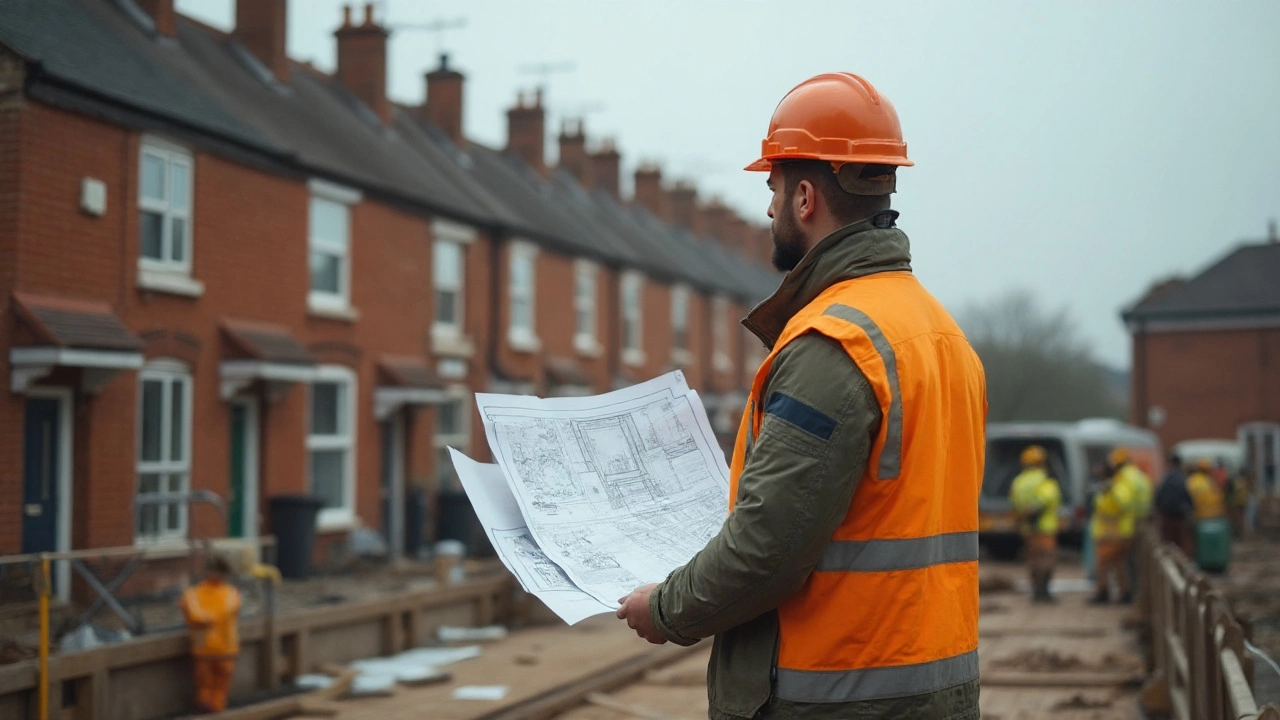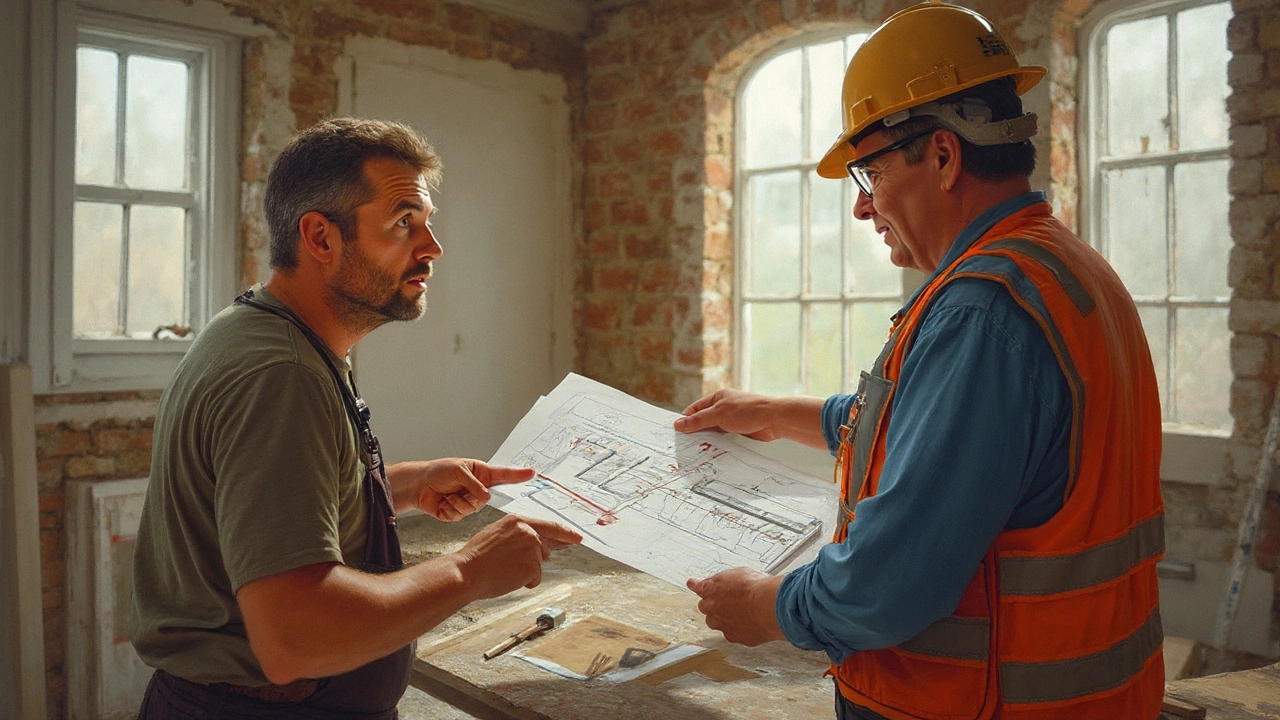
If you’ve ever stared at a renovation disaster, scratched your head, and thought, "How does anyone actually pull this off?," you’re not alone. Behind nearly every remodeled kitchen, new addition, or even that shiny new office downtown, there’s a contractor juggling a mountain of responsibilities, phone calls, and coffee cups. But most people only catch a glimpse of what these folks actually do. And it’s way more than showing up with a hammer and a smile.
The Contractor’s World: What’s Really Happening Behind the Scenes?
Picture a tightrope walker, but instead of balancing on a rope, a contractor balances crew schedules, supply shipments, city inspections, and the ever-changing weather forecast. Most people think contractors just hire the right tradespeople and tell them what to do. Sure, that’s a piece of it, but that’s kind of like saying a chef just tosses salad. A proper contractor is a master planner, translator, negotiator, and problem-solver rolled into one. They often start by meeting with clients — homeowners, business owners, or developers — to figure out what the project is supposed to be. This means listening, clarifying the vision, and sometimes breaking hard news about what’s realistically possible within the budget or timeline. Some contractors specialize — say, only kitchens or new builds — while others manage projects of every stripe.
Once the plans are sketched and the paperwork signed, contractors become project architects. They read blueprints (or have them drawn up if you’re starting from scratch), pull permits, and map out a plan that fits the budget. And trust me, permits are no joke. Cities and towns treat them like a golden ticket. Without them, your sunroom or restaurant expansion might get shut down faster than you can post it on Instagram. A solid contractor knows the inspector’s name, the city’s quirks, and exactly what needs to be on that form. There’s also the challenge of choosing the right crew. Hiring trustworthy carpenters, plumbers, electricians, and painters isn’t about rolling the dice. Contractors often rely on a tight network they’ve built over years — the people who actually show up, do the job right, and don’t disappear when it rains.
Managing the crew is a lesson in diplomacy and time management. On any given morning, a contractor might answer questions from an electrician about the wiring plan, confirm that the right kind of insulation was delivered, then soothe an anxious homeowner worried about tile colors. It’s hands-on. Good contractors spend plenty of time on-site, not just in the office shuffling papers. A 2022 survey by the National Association of Home Builders found that more than 70% of contractors clock over 50 hours per week when they’ve got jobs running. And it’s not just hammering or sawing — it's checking on progress, troubleshooting problems, and making sure code requirements are met. If the plumber hits old, leaky pipes no one expected, or if supply shipments arrive late, the contractor finds the fix and keeps the project moving.
Let’s get real about money. Contractors create detailed estimates before a job starts, often using special software to break down labor, materials, permits, and contingency funds for the surprises that always turn up. Being off by even 10% on a big project could mean thousands of dollars lost. Most contracts spell out payment schedules tied to milestones: a deposit up front, payments after certain tasks, and the final check only when everyone’s happy. Smart clients never pay the full amount until the punch list (the list of little fixes at the end) is done. Contractors need to be part business manager, part lawyer, and all realist when it comes to billing and contracts. Whether they’re independent or working with a firm, contractors also pay their own insurance, taxes, and sometimes workers’ comp — another set of hats that never seem to fit quite right.
Steps in a Contractor’s Day: From Blueprints to the Final Walkthrough
Want to see what an actual contractor’s day looks like? Here’s a breakdown that hits closer to the real world than any home-improvement show ever could.
- Planning and Prep: Every contractor starts the day with a massive to-do list. Bet you didn’t think half the job involved making sure the new windows arrive on Thursday, not Friday, so the whole house isn’t wide open to the elements. If a crew is starting demolition, contractors double-check the plans, flag hazards like asbestos, and coordinate the right dumpsters.
- Job Site Management: Contractors are constantly bouncing between sites or from job site to office, keeping a pulse on each project. The goal: keep things moving. One late delivery or sick crew member can throw weeks of planning off track. According to a report by McKinsey, construction projects still run late about 80% of the time — the smallest slip can snowball.
- Problem Solving: Something always comes up. Maybe there’s a hidden vent in the wall, or the tile shipment is the wrong color. Contractors usually have a Plan B and Plan C. They talk to the client, talk to suppliers, make a call, and pivot without blinking. This knack for handling chaos quietly is their real superpower.
- Client Communication: Regular check-ins keep everyone sane. Contractors explain what’s happening, what’s next, and any bad news, like unexpected costs or delays. The best contractors don’t sugarcoat — they set realistic expectations and back it up with solutions. Transparency is the name of the game.
- Inspections & Quality Control: At key points, work has to be inspected — either by the city, an engineer, or the contractor themselves. If drywall covers up something that’s not to code, tear-out and redo are the only options. So contractors stay vigilant, walking the job with a sharp eye and a tape measure.
- Final Touches: Getting to "done" means addressing the punch list: that wobbly cabinet knob, missing light fixture, or smeared paint line. Only when both the contractor and client are satisfied does the project wrap up, payments finish, and everyone heads home — at least until the next job starts.
Here’s a snapshot of how much time gets eaten up on the job by each part of the process, pulled from an actual contractor time tracking tool in 2024:
| Task | Average % of Day |
|---|---|
| Job site and crew management | 40% |
| Client communication | 15% |
| Paperwork & permits | 10% |
| Problem solving | 20% |
| Estimates & billing | 10% |
| Inspections / Quality checks | 5% |
Surprising? Most contractors spend more time wrangling logistics, paperwork, and people than swinging a hammer. That’s what keeps jobs on track.

Surprising Realities: Challenges and Truths About Working as a Contractor
The life of a contractor isn’t for the faint of heart. Besides balancing details, deadlines, and sometimes difficult customers, there’s a whole lot of unpredictability. One day, you’re rolling ahead on schedule — the walls are framed, everyone’s in sync — and the next, a shipment is delayed a week or a crucial crew member calls in sick. Materials are always in flux. Remember when lumber prices in 2021 shot up by over 300%? Even now, supply chain hiccups can force last-minute substitutions—contractors have to be on their toes, constantly updating quotes so no one is blindsided by higher costs.
Then there’s labor. Skilled tradespeople don’t grow on trees. A shortage of good workers means contractors compete for the teams that show up, do tight work, and respect your time. Many contractors invest in ongoing training or apprentice programs to keep their crews sharp. And don’t forget, they have to play psychiatrist, too, whether it’s calming a panicked homeowner who’s convinced the paint isn’t the right shade or refereeing a squabble between the electrician and the tile guy. No two days ever look the same.
There’s also the legal side. Most reputable contractors are licensed and insured, but requirements vary by location. For instance, in California, you can’t pull a residential permit without State licensing — and if you try, you risk hefty fines or having your project shut down. Many states post lists of licensed contractors online, and smart homeowners check them before signing anything. Contractors also keep liability insurance, which protects both themselves and their clients if something goes wrong — from busted pipes to broken bones. Ignoring that paperwork is a one-way ticket to lawsuits and stalled projects.
Speaking of risks, accidents on job sites happen. According to the U.S. Bureau of Labor Statistics, construction still ranks among the most dangerous professions, with fall injuries, tool mishaps, and heavy equipment accidents making up a sobering chunk of annual workplace incidents. Contractors take safety training seriously and push their crews to follow strict protocols, even if it slows things down. Someone’s always watching — and rightly so. The good ones treat safety checks as a daily ritual, not an afterthought.
Above all, contractors are all about reputation. Word of mouth still rules this game. One project done well can snowball into years of steady work, while a single botched job haunts you for ages. It’s not uncommon for contractors to turn away jobs they can’t handle, or clients who seem impossible to please — because a bad gig costs more in the long run than saying “no.” Read local forums or neighborhood apps, and you’ll spot the same names again and again, either sung for saving the day or dragged for ghosting after the check clears. Choose carefully, because the stakes are high for both sides.
Tips for Hiring — and Working With — the Right Contractor
Find yourself staring down a remodel or new build and wondering how to pick a contractor who won’t leave you in the lurch? Start by skipping anyone who won’t show proof of licensing, insurance, or a solid local track record. Do an online search for complaints with your state or city agency. No one’s perfect (especially in construction), but a long list of angry customers is a red flag. Most reliable contractors give detailed, written estimates and explain every line. If someone gives you a price scrawled on a business card, run for the hills.
- Don’t just take the lowest bid. If it seems too good to be true, it probably is. Cheap often means shortcuts, and that almost always comes back to bite you. Ask for a breakdown: labor, materials, supervision, and clean-up. Everything should be spelled out before a nail is hammered.
- Meet face to face. Chemistry matters. You’ll be asking this person to spend weeks or months on your property or project. Look for someone who answers questions straight up and doesn’t dodge the tough ones. If you feel like you’re being rushed or brushed off, keep looking.
- Clarify who will actually be on the job. Sometimes the person who sells the contract isn’t the person managing the work day-to-day. Get names, see if the crew is sub-contracted, and ask how often the main contractor will be on-site. No one likes surprises — especially when a different “supervisor” shows up each day.
- Payment schedule should be fair and tied to progress. Never pay more than about a third up front. Each payment should match a clear project milestone, such as finishing framing or passing inspection. Hold back the final payment until the punch list is finished — you want leverage if something needs fixing.
- Communicate early and often. Things change on site all the time. Maybe you want to switch the floor tile, or an unexpected surprise pops up behind the old drywall. The best jobs run on teamwork — and text messages. Don’t wait to voice concerns or ask questions. Skilled contractors would rather solve a problem early than re-do work at the end.
- Document everything. This protects both you and the contractor if questions come up later. Snap before-and-after photos, keep copies of contracts, and save any permits or inspection reports. If it isn’t in writing, it’s all too easy for details to get lost in the shuffle.
One more inside tip: check if your contractor belongs to any trade associations or carries industry certifications. Groups like the National Association of the Remodeling Industry and the Associated General Contractors of America require members to follow certain ethical standards and often offer dispute resolution if there’s a problem. Not all membership badges are created equal, but the best ones signal a willingness to play above board.
So next time you see a smooth-running project, know that beneath the surface, there’s a contractor working a dozen angles — pulling strings, soothing nerves, and steering the whole ship to the finish line. That’s how you spot the real pros.




